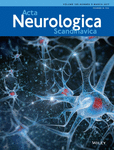Genetic analysis of PITX3 variants in patients with essential tremor
Abstract
Background
A clinical overlap between essential tremor (ET) and Parkinson's disease (PD) has prompted investigation whether these disorders share common genetic factors. The paired-like homeodomain transcription factor 3 gene (PITX3) has been shown to play an important role for the differentiation and survival of midbrain dopaminergic neurons in the substantia nigra pars compacta. The preferential degeneration of those dopaminergic neurons is the pathological hallmark in PD.
Aims of the study
The purpose of this study was to evaluate whether PITX3 variants are related to susceptibility of ET in Chinese Han population.
Methods
Genetic analysis of two variants rs3758549 and rs4919621 of the PITX3 gene was conducted in 200 Chinese Han patients with ET and 426 controls.
Results
We did not identify any statistically significant difference in either genotypic or allelic frequencies of variants between the ET patients and control cohort (all P > 0.05). Haplotype analysis of two variants in the PITX3 gene showed no potential association between the haplotypes and risk of ET (all P > 0.05).
Conclusions
Our data suggest that PITX3 variants rs3758549 and rs4919621 are not associated with ET in Chinese Han population.




